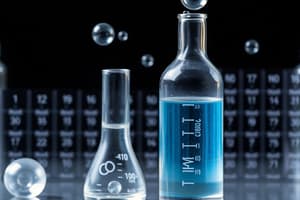Podcast
Questions and Answers
What determines the position of elements in the periodic table?
What determines the position of elements in the periodic table?
Atomic number and electron configuration
How are ionic compounds formed?
How are ionic compounds formed?
By the transfer of electrons between metals and nonmetals
Give an example of an ionic compound.
Give an example of an ionic compound.
Sodium chloride (NaCl)
How are covalent compounds different from ionic compounds?
How are covalent compounds different from ionic compounds?
What are the two main types of chemical bonds found in compounds?
What are the two main types of chemical bonds found in compounds?
What concept in chemistry helps predict how elements react based on their electron arrangements?
What concept in chemistry helps predict how elements react based on their electron arrangements?
Explain the difference between polar and nonpolar covalent compounds.
Explain the difference between polar and nonpolar covalent compounds.
How does the law of conservation of mass relate to balancing chemical equations?
How does the law of conservation of mass relate to balancing chemical equations?
What is the role of coefficients in balancing chemical equations?
What is the role of coefficients in balancing chemical equations?
Give an example of a covalent compound and explain why it is covalent in nature.
Give an example of a covalent compound and explain why it is covalent in nature.
How do ionic compounds differ from covalent compounds in terms of their bonding?
How do ionic compounds differ from covalent compounds in terms of their bonding?
What fundamental concept in chemistry is illustrated by balancing chemical equations?
What fundamental concept in chemistry is illustrated by balancing chemical equations?
Flashcards are hidden until you start studying
Study Notes
Chemistry
Chemistry is the study of matter and its properties, interactions, composition, and changes. It involves both organic and inorganic compounds, including elements, molecules, and other forms of matter. In chemistry, we often deal with various types of chemical reactions and compounds, such as ionic and covalent ones. Some key concepts in this field include the periodic table, balancing chemical equations, ionic compounds, and covalent compounds. Let's dive deeper into each of these areas.
Periodic Table
The periodic table organizes all known elements based on their atomic numbers, electron configurations, and recurring chemical properties. Elements are listed in order of increasing atomic number. Each element has its own unique set of electrons, which determines its position within the table. By understanding the periodic table, chemists can predict how elements react with each other based on their electron arrangements.
Ionic Compounds
An ionic compound consists of positively charged ions called cations and negatively charged ions called anions. These compounds form when metals lose electrons to become cations and nonmetals gain electrons to become anions. Ionic bonds form between these oppositely charged ions, creating stable compounds. Examples of ionic compounds include sodium chloride (NaCl), calcium carbonate (CaCO3), and potassium sulfate (K2SO4).
Covalent Compounds
In contrast to ionic compounds, covalent compounds are formed when atoms share electrons. The atoms in a covalent bond share electron pairs, which creates a stable molecule. Covalent compounds can be either polar or nonpolar, depending on the electronegativity difference between the atoms involved. Examples of covalent compounds include water (H2O), methane (CH4), and carbon dioxide (CO2).
Balancing Chemical Equations
Balancing chemical equations involves adjusting the coefficients (the numbers in front of the chemical formulas) to ensure that the number of atoms of each element is conserved on both sides of the equation. This is done by adding coefficients to the reactants and products so that the number of atoms of each element is the same on both sides. This ensures that the law of conservation of mass is obeyed.
In conclusion, chemistry is a diverse and fascinating field that deals with the properties and interactions of matter. Understanding concepts like the periodic table, ionic and covalent compounds, and balancing chemical equations helps us better understand the world around us and the chemical reactions that occur within it.
Studying That Suits You
Use AI to generate personalized quizzes and flashcards to suit your learning preferences.




